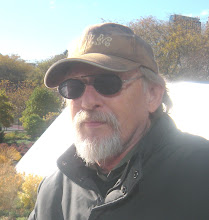I read several facebook groups on Tai Chi Cuan and have noticed a recent trend toward analyzing photographs of past Tai Chi masters. This sometimes entails the drawing of lines over the photos to show alignments and to determine weight distribution. I am obsessed as much as the next person with “doing it right” but I have to question the process of ferreting out the “rightness’ of a three (four?) dimensional event using two dimensional tools.
Photography has a history of being used to analyze position and motion that is as old as photography itself. The classic example is Eadweard Muybridge http://en.wikipedia.org/wiki/Eadweard_Muybridge (1830 - 1904) who was an English photographer working in the American West. He is most famous for producing numerous studies of people and animals in motion using a series of cameras to capture successive stages of the body in motion through space.
In 1981 I wrote a book on animation called The Shoestring Animator, in which I used one of Muybridge’s motion studies, one called “Man Walking at Normal Speed,” as an aid to developing a hand-drawn animated “walk cycle.” It is thought that several early animation artists studied Muybridge to originate their own techniques. I pointed out that Thomas Eakins, a painter contemporary to Muybridge who used photographic studies in his own work, felt Muybridge’s panels were flawed since each successive camera viewed the action from slightly different position. I went on to say that the photos were close enough (for government work).
Animation is not Tai Chi, although there is a relationship in that both involve bodies in space and motion. The facebook posts analyzing Tai Chi reminded me of my own use of photos to create animated films. I often utilized a technique called “rotoscoping” in which live action cinema frames are traced and then rephotographed. To paraphrase one of my fellow filmmakers, Mary Beams, you can learn a lot about the universe by tracing live action. One thing you learn is that motion picture film doesn’t accurately reproduce motion. Here is why.
Because film is a series of still pictures taken one at a time, there is movement in between each exposure that is not recorded. Also, the frame rate of motion picture photography is 24 frames per second allowing a certain amount of blurring of the moving subject. Animators know this and exaggerate key positions of their drawings to make them more “life like.”
I think I blogged previously about the difficulty in using videos to learn Tai Chi. I remarked that the camera angle often hides or distorts some of the action. Since videos are not the best way to study motion, how can it make sense to use a still picture to learn Tai Chi? Photos of Cheng Man Ching and others were not taken as they moved. They were posed. Perhaps they were posed to display an emphasis on weight distribution or alignment at a particular time during the form, but I suspect these illustrations have to be taken as instances of the spirit of the movement and not written-in-concrete icons of the art. Can you photograph Chi? Can you diagram it? I think exploring the examples of the great masters through photographs is rewarding and enlightening but should be approached cautiously. I think of the book, The Da Vinci Code, and how searching for hidden code in the painting of the last supper really distracts from the ascetic enjoyment of a great work of art. I hope we don’t over analyze Tai Chi in the same way.
Tuesday, October 5, 2021
Subscribe to:
Post Comments (Atom)



No comments:
Post a Comment